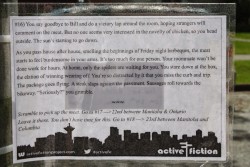Jim Munroe wears many hats: he writes novels, comics, and films, and with all the spare time those afford him he designs games as well. In the IF community, he’s best-known for placing third in the IFComp twice, in 2008 with Everybody Dies and in 2012 with Guilded Youth.
Rowan: Welcome to award-winning game designer Jim Munroe! In your early years, prior to landing that Managing Editor spot at Adbusters magazine, you were somewhat of a technologist, publishing e-zines in a computer medium at least if not programming back in the ’90s.
Jim: I just went to see if I could find the 3.5″ disc I “published” in the 90s … doubt I would have dated it on the label anyway. Even my paper zines, which I started when I was 17 (1989), were number v1.0, v2.0 etc. and as soon as I could upload e-zines and then e-books to the Gutenberg Project I was doing it, just because I thought it was cool that people could login to a server anywhere and read my ramblings. I forget when I came across the IF community but when I did I was thrilled by the fact that people were still making these games that I loved when I was a kid (the familiar story) and so despite having no programming skills I decided to take advantage of the tutorials out there and learn Inform 6. ‘Cause really the killer feature for me with Inform in general was the Z-machine format — the idea of being able to create work in the same format as your childhood games was weirdly compelling.

I’d be remiss to not follow the obvious lead: favorite titles from the classic text adventure era? Favorite IF stories from the revival era? Other story-games you’d like to single out as meritorious and, perhaps, inspirational?
Wishbringer and Lurking Horror gripped me as a youth. Grim Fandango and Half-Life got me back into games after a decade away. Savoir-Faire blew my mind and probably is the biggest reason I got back into writing IF again. It’s better than anything Infocom made.
Interactive fiction is a marriage of writing and programming, and often what we see are stories written by programmers rather than games programmed by writers. My understanding is that you came at this distinctly from the writers’ camp from far back. It’s a steep hurdle for writers to take on the programmer mantle, one you first conquered with Punk Points back in 2000. I know that’s ancient history, but do you have any memories of first conquering the pinnacle of Mount Text Adventure Programming?
Weirdly one of my few memories of writing the thing was that I was at a writer’s festival in Ottawa (my book Angry Young Spaceman was out at the time) and I was coding a chunk of it on an HP Palmtop computer. I couldn’t compile it or play it on that thing but I was determined to get the thing done and it was Ottawa, so there I was in this fancy hotel room pecking away at this tiny handheld. As far as “conquering” Mt TAP, that was hardly the case… it had pretty shallow implementation and many other flaws. Punk Points had its fans… but the main thing though is that it got a decent amount of feedback. And while it took me seven more years to do another one, it was the memory of that — especially Jon Blask’s letters and the XYZZY nomination — that made me feel welcome.
It still took you quite a while to prepare for another expedition up Mt. Interactive Fiction, but you were a busy fellow in the meantime, exploring other ways of telling stories with games like machinima. Did you just fall into that? Is your brain hard-wired for narrative even against a game engine fighting you?
Ha ha, no. Machinima (and My Trip to Liberty City predates that unfortunate name) is something I did with the tools I had at hand. Narrative is easy for me but I want to try and move in a less linear direction. Mostly because I feel that the cool thing that games can do is be player-directed, dynamic, less about plot. If I have a linear narrative I can work in film or novels, right?
Conspicuously the Inform 7 revolution elapsed between your first and second piece of IF. Did you ever look back?
My memory is so shit that if I decided to work with 6 again I would have had to learn it from scratch. Really I7 is made for programming challenged folks like me so I needed to give it a chance. My feeling, though, is that its syntax is almost as unforgiving as normal coding, so it doesn’t make things easier so much as make them look easier — by the time you realize your mistake, you’re committed. But personally I think the tutorials are a work of art on their own. I think it’s a really good tool and it works for me.
A quick comment on tools — I don’t care too much about them. I think discussion around them is kind of annoying, like when people ask me at movie Q&As about what we shot on. Who cares? It’s as if people are trying to find the perfect tools before they can make the perfect art.
So as a onetime DIY zinester, you hold by Socalled’s ethic to work with what you got?
Yeah, work with what you got for sure. Tool fetishization is a kind of procrastination. So I kind of feel bad not enthusing about I7, because I’m sure it’s a triumph of various magnitudes… I’m not really knowledgeable enough to comment on the craft behind I6 vs I7 but I can say for sure that I’m inspired by Emily’s work on the tutorials and Graham’s community building.
I was curious, wondering whether you’d tried any new tools like, specifically, Twine.
As a player CYOA or hyperlinked stuff has never worked for me. It’s always felt like button pushing.
That can’t be entirely true, you must have made your Pick-Your-Own-Podventure for some reason! Perhaps your distaste for the format informed your failure to produce a part 2?
You know what? It was the very little feedback I got on CYOP that made me lose interest in following it up. It seemed like a cool idea! I thought it was going to get more attention.
With Guilded Youth joining the fray, there is now a small ludographical body of works engaging the forgotten, poorly documented technological dead-end of the BBS. Your Guilded Youth, Digital: A Love Story and Endless, Nameless are about all I can think of… all emerging relatively recently, and more to the point, well after the fact. Why now? Do you think we’ll see any more?
Dunno! Weird fact — both myself and Love are in Toronto. She’s in her early 20s, which means that she never experienced the BBS scene in its heyday. I did, but not being particularly reverent about it or having a good memory means that my take on it was largely an imagined history. She needed to do research by necessity so hers is probably more authentic in a way!
You’ve said that Guilded Youth represents the end of a trilogy of games set in your teenaged stomping grounds of Toronto suburbs. I know I first got on board the Munroe ship when I read a book you had written, Everyone in Silico, elapsing partially in my own hometown of Vancouver, plus I’m sitting next to a comic you wrote set in an alternate Detroit. Geography figures prominently. Where are your sights leveled next?
Hmm, dunno! Probably more Toronto stuff. I’m a dad now so other than publicity tours I don’t travel much, and I generally like to live in places I steal for fiction.
So, about Toronto: lots of folks — well, folks in San Francisco and Boston as best as I can tell — are finding they recharge their batteries and get good input from other IF enthusiasts in their area whom they meet up with. You’re a DIY community empowerer, putting tools in the hands of the people and demonstrating by example, so I might ask you about the buzzing Hogtown IF community that you’re central to. However, as best as I can tell, there isn’t one! You do, however, help people learn to make games… which must on some level be cogent. What’s that about? Have you evangelised IF or was My Uncle George a happy coincidence?
Well, actually, it’s a bit more convoluted than that. The Artsy Games Incubator was something I did three rounds of and then Miguel Sternberg took on running the 4th and that was the one Phil did his IF in. I think he knew about Everybody Dies. Honestly the general indie community in Toronto rather than specifically the IF subgenre is something I’ve contributed to via the Hand Eye Society, where I’m the executive director. I might do a IF specific incubator in the future — there is a bit of interest in it.
You have stakes planted in all sorts of media ventures — books, films, comics, and games — many of which are collaborations with other artists. Relatively few of your works are, as best as I can tell, cross-promotional across media… Roofed being the exception here. Do you see good prospects for games out of your prior works, or novels or comics out of your games?
The classic question is generally “why don’t you make movies out of your books?” Which kind of makes sense except that I make stuff for the fun of releasing something new into the world, and if it’s the same kind of thing I find it boring. So in general I like working with whole cloth, so to speak.
You seem to have taken an enviable turn for the award-winning in your recent games. Tips? (“Only release games that are entered in contests, and make them well?”)
It’s pretty crazy. Well, I haven’t won much for my writing or movies… I think it’s a case with games of being what the culture wants at the right time. Unmanned as well is a collaboration with a hugely respected and awesomely talented game-maker.
I don’t see you campaigning for votes (blessed silence in this noisy Kickstarting era) but you do seem to have accrued some cheerleaders (hi, there!) on the strength of your extensive back catalogue and its quality. They partially boost you on your novel strength of just wondering “What it is he’s going to do next?” “What medium will it be in?” “I hear he throws darts at a dart board to find out!” “No, he’s an I ching man!”
Ha ha ha, if only it was as scientific as darts!
Which is the natural opening to invite you to tell the SPAG readers: what’s next?
I’m working on a touchscreen interactive fiction prototype. Both game-wise and otherwise it’s a prototype of a new interface that is simpler than a parser but gives the reader more agency than a hypertext or CYOA. That’s all I’ll say!
A stiff order!
Or maybe I should say it gives the impression of more agency. About appearance of agency vs actual agency… what I often come back to is verisimilitude, you know it? As a writer you try to give the appearance of gritty reality without having to write about every heartbeat, every intake of breath, every shit… a few choice details give the impression of realism, and I think that holds true for agency as well: a few key, unexpected choices. No no, verisimilitude is the “appearance of reality” as opposed to literal reality…
You’re getting Platonic on us!
Sorry man, second year English class. The literary idea, as I remember it from my creative writing classes in a suburban Toronto university, is that small details of realism are better than a transcript of each moment or detail. You don’t have a responsibility to be endlessly detailed; as a writer what you want to do is give the reader a detail or two that proves that you’re a close observer, and as a game designer what I ideally aim for for is not to give the player endless choice but to give them unique choices that they’d never seen before in a game. That being said, I feel like I have a long way to go as a game designer… but that’s what I’m working towards. I think that’s one of the things that works about Unmanned — when I see people playing it, they really consider their choices: “What do I want this guy to be?” “Am I this guy?” “How can I win this?” All the important processing is going on in the player’s head. The game itself is ridiculously simple: branching narrative.
Processing powered by the same engine that draws the pictures in readers’ heads between comic book panels.
Exactomundo!
Which leads me to inquire after your somewhat iconoclastic use of pictorial illustration in your recent comp games… have these helped the games’ receptions? They seem to have! But what a design decision to make, given that it’s more work for you to push the tech beyond what it’s intended for just to challenge the somewhat rigid tastes of the voters.
Yeah, actually it is kind of surprising that they’ve been as well received as they have. I don’t know that the community is that conservative… I think the fact that the IF gatherings were at PAX East for a while indicates a greater affinity for videogames than literary work.
Video games are the lowest common denominator between the two there: a writer who cannot program cannot make a work of IF, while a programmer who cannot write can easily make a very crappy one. The conservatism isn’t as big an issue now (now that all the CYOA enthusiasts are coming out of the closet, for example,) but at the time of Everyone Dies the big question wasn’t “What’s the significance of the fish?” but rather “What on God’s green Earth are pictures doing in my text adventure?!@#”
Ha ha! The fact that they were so awesome probably won people over. I have them on my wall right now!
Should we expect illustrations in your future works? You’ve put pictures in two IF games but sounds in none — that can’t be entirely coincidental can it?
 Pictures? Maybe! Honestly I don’t think too much about it. As for sounds… no, you’re wrong! Go back and play Guilded Youth in Chrome and prepare to have your ears blown out!
Pictures? Maybe! Honestly I don’t think too much about it. As for sounds… no, you’re wrong! Go back and play Guilded Youth in Chrome and prepare to have your ears blown out!
Finally you have bested me, Munroe! And on that note, that’s all the time we have for this interview. A big thanks to Jim for surfing the time-zone gap in order to share his thoughts with us about yesterday, tomorrow, and of course today — yesterday’s tomorrow!
Thank you man, it’s nice to know some people are paying attention even to the ignored projects.
Hey, my credo is of course that interesting failures are much more worth investigating than boring successes!
Tru dat!
 ructor Timothy Taylor, who posed the challenge to his students. The first to rise to meet it, Nicole Boyce, presented the inaugural Active Fiction story in May of 2014, in conjunction with a series of walking tours celebrating the ideas of urban planner Jane Jacobs. It was entitled The Raffle, and concerns itself with an attempt by a new arrival to town to make some friends in the area. (SPOILER ALERT: A meat draw in the Legion Hall figures prominently, lending the piece its name.)
ructor Timothy Taylor, who posed the challenge to his students. The first to rise to meet it, Nicole Boyce, presented the inaugural Active Fiction story in May of 2014, in conjunction with a series of walking tours celebrating the ideas of urban planner Jane Jacobs. It was entitled The Raffle, and concerns itself with an attempt by a new arrival to town to make some friends in the area. (SPOILER ALERT: A meat draw in the Legion Hall figures prominently, lending the piece its name.)



